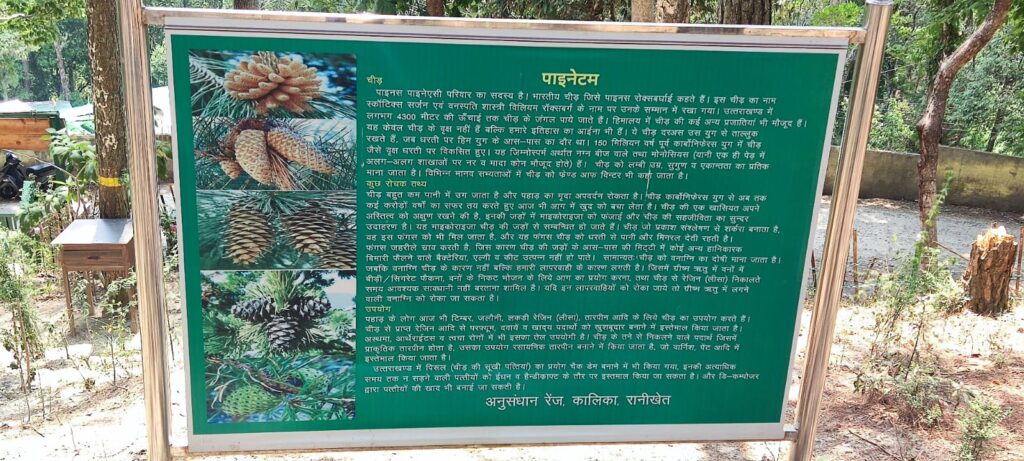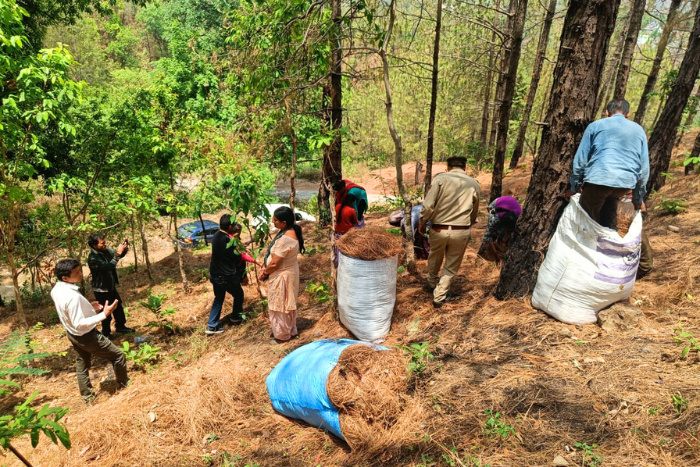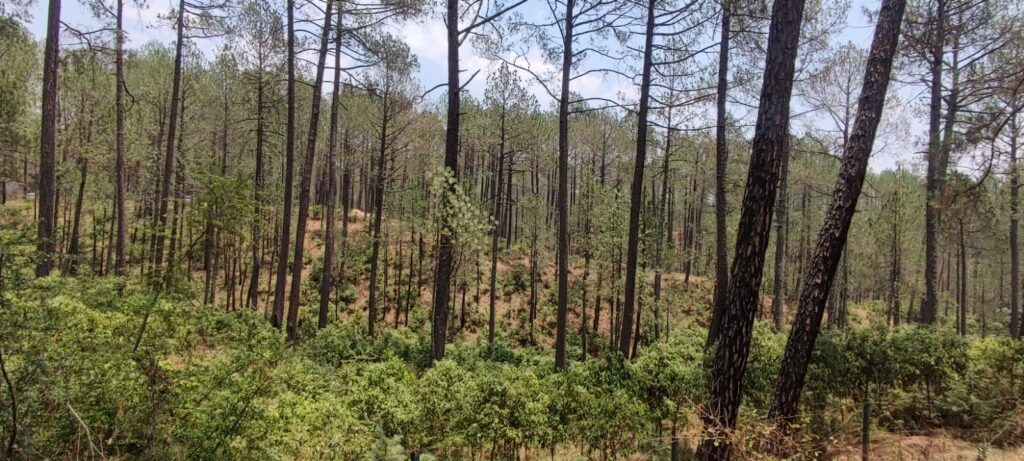


Even as the Uttarakhand govt blames the rapidly growing presence of pine for the uncontrolled forest fires in the region, the absence of fire lines, inadequate forest staff, climate-induced dry weather and inadequate rainfall also need to be acknowledged in order to find a sustainable solution to the issue, say experts Read more
A scene of burning forest in Kumaon region of Uttarakhand. Photo - Jaimitra Singh Bisht
Is pine the real ‘villain’ in the Uttarakhand forest fire saga?
Even as the Uttarakhand govt blames the rapidly growing presence of pine for the uncontrolled forest fires in the region, the absence of fire lines, inadequate forest staff, climate-induced dry weather and inadequate rainfall also need to be acknowledged in order to find a sustainable solution to the issue, say experts
In May this year, visuals of Uttarakhand chief minister Pushkar Singh Dham clearing pine leaves (pirul) appeared in the media. “Dry leaves of Pirul are the biggest cause of forest fires,” the CM said, while announcing the government’s ‘Pirul Lao-Paise Pao’ campaign, aimed at incentivising locals to help the forest department in collecting pine leaves.
This year, amidst a prolonged spell of hot and dry weather, Uttarakhand saw more than 1,200 incidents of forest fires, which claimed the lives of at least 10 people, including some forest guards. One could argue this campaign was the government’s attempt to pivot the blame away from grim ground realities and solely towards these age-old pine trees. While it is true that pine in the Himalayan forests is seen as a major cause for the spread of forest fires— the inflammable leaves and resin cause the fire to spread rapidly and go out of control—there are much deeper issues also at play here. The absence of fire lines— which are strips of open land in a forest that stop a fire from advancing—and inadequate labour to control these fires are two major factors. Climate change also plays a big role in aggravating forest fires. Inadequate winter rain—which provides moisture that stops fires from getting out of control—protracted summers and higher temperatures are also fuelling these fires, experts say. This year, Uttarakhand recorded a rise in winter wildfires. In the past five months, severe fires have occurred even in those forests where there is no pine or very little of it.

But instead of addressing all these issues together, the Uttarakhand government’s decision to “villainise” one species, whose frequency and scale is rising, is a myopic strategy and will prove to be detrimental in the long term, experts say. Pine is just one conifer standing among many other species in the Himalayan slopes. Focusing solely on it shows the government’s incorrect understanding of the larger Himalayan ecosystem and is leading to unsustainable solutions to the forest fire issue, according to experts.
Pine has been an integral part of India’s mountain forests cover since the Himalayas first formed. Experts say in order to curb forest fires, a more holistic approach is needed, which acknowledges the laws of the jungle and tries to address the human factors for the spread of forest fires.
Forest fires are man-made
Almost all forest fires are anthropogenic and caused by human activity. Villagers burn dry grass in the hope of getting better growth of fodder for their cattle. This can sometimes lead to major fires. Leaving a lit cigarette, cooking or a bonfire left burning can also trigger forest fires. Poor waste management also forces locals and authorities to burn garbage to get rid of dry waste, triggering fires.
However it is important to understand not all forest fires are destructive. The sporadic fires contribute to maintaining the health of the ecosystem. They play a vital role in forest ecology by clearing the accumulated weeds and recycling nutrients. These fires also help in seed germination. But climate change is tipping this effect of forest fires from being producing to destructive. It is triggering frequent, uncontrolled and large forest fires that not only destroy biodiversity and precious forest resources, but also increase the danger of flash floods by ruining the top layer of soil.
Officials of the forest research department of Uttarakhand say that these large forest fires have endangered not only the valuable plant species, but also the “rare species of birds (like the native cheer pheasant, kalij pheasant and common rose etc.) whose breeding season coincides with fire season from April to June.” Several hundred species of butterflies critical for biodiversity may be at the “verge of getting endangered” as host plants are getting consumed by forest fires.
How is pine linked to the spread of forest fires?
The spread of forest fire is attributed to pine because of the inflammable dry leaves, which it sheds heavily during and before the fire season. Kamlesh Jeena, a volunteer villager engaged in dousing the forest fire in Kumaon region of Uttarakhand said, “Due to pirul, the fire takes a very dangerous form and spreads rapidly and becomes uncontrollable. It seems as if petrol has been set on fire. There is a risk to our lives in extinguishing it.”
Besides, there is resin that is extracted from pine trees for commercial purposes. To collect resin, marks are made on the trunks of trees from where this sticky liquid seeps out. When there is fire in the jungle, this liquid is inflammable.
Shekhar Pathak, the historian who is studying western and central Himalayan region for the last five decades says, “When the fire reaches up and resin [seeping out of the trunk] catches fire, this burning-lump may blow with the high speed wind and spread the fire in other parts, too. Now we have photographic evidence about this. Therefore it is important to understand the territory of chir-pine to keep the fire in check.”
How pine grew to dominate the Himalayan forests
Pine is a native tree species of India. Contrary to popular belief, it was not introduced by the British, but over the decades it received favourable conditions to grow and dominate in the mountainous landscape. Today, there are as many as 8 native and 21 exotic species of pine in India. It was always beneficial for the government to grow pine for its resin, which is used in turpentine oil, soap, paper, paint and chemical industry. It has been an important revenue-earning source for the government since the colonial period. Even now, the Uttarakhand government earns around ₹200 crore annually from the resin.

Pathak says the British were so aware about the commercial benefits of resin from pine that in the early 19th century they established a small factory unit in Kashipur, Uttarakhand, to exploit its benefits.
“That was perhaps the first enterprise of the British in the Himalayas even before colonising the hills. At that time, East India Company did not have the administrative control over Kumaon, but they had already set their eyes on this resource and launched the commercial initiative,” Pathak said.
The British expanding its railway network in India in the 1850s was a turning point in the ecological history of the Himalayan forests. Within a period of about 60 years, between 1853 and 1910, the network of railways increased from a mere 32 km to more than 51,000 km. An enormous amount of wood was required for railway tracks and coaches. Teak, oak, deodar and sal from these forests were cut for fuelwood and construction purposes. The expansion of railway, therefore, coincided with the growing presence of pine in the Himalayan forests.
GS Rawat, emeritus scientist, Uttarakhand Council for Science & Technology ((UCOST), & formerly dean with Wildlife Institute of India (WII) said, “Exploitation of forests and other resources in India did not stop even after the British left. Sal and deodar usually do not share the habitat with pine. Hence, it may not be correct to say that commercial extraction of sal and deodar during the British period may have led to expansion of pine. But there is no doubt that the mid-elevation broadleaf tree, oak, locally known as baanj (Quercus leucotrichophora) has been the most favoured fuel wood and fodder species for the local people in Uttarakhand. Degradation of oak forests, especially on south-facing slopes, and frequent fires in oak forests could have led to the expansion of pine. Chir Pine is not an ideal species for making railway sleepers as it is less durable and more resinous compared to sal.”
Pine vs oak: More emotions, less science?
Some other researchers have argued that Chir Pine is encroaching into the space of Banj Oak, thus making the forests more fire prone. In the mountainous landscape, in the context of forest fire and ecological balance, the characteristics of needle-leaved Chir Pine are often compared with broad-leaved Banj Oak (quercus) as they grow in a common habitat. It is generally believed that pine makes the surrounding land arid, whereas oak trees hold water and provide moisture to the soil, creating a healhty ecosytem. Several experts working in the Himalayan region for decades told this writer that there are “many misconceptions” about pine and oak and most of the things are said in “emotional outbursts which have no scientific basis.”
Professor Chandra Singh Negi, a zoologist professor in MBPG College, Haldwani, Nainital, who has been researching on Himalayan ecology for over two decades says, “The truth is contrary to popular belief. Pine grows in xeric conditions and oak needs good moisture. If you plant oak in dry conditions it will not grow. Often people say that we will cut down the pine and grow broadleaf species like oak to make the jungles safe (from forest fires), but it won’t be successful.” Pine, on the other hand, adapts well to the lack of moisture and thrives in dry conditions, which have been increasing in the Himalayan region thanks to climate change. Unlike oak, its thin, needle-shaped leaves have less surface area and the tree loses less water. Its conical shape, waxy coating on the leaves and deep roots provide an added advantage.
This study observed a substantial reduction of banj oak forest habitats in the Western Himalayas between 1991 and 2017, while pine forests expanded considerably. Another study found that the Banj Oak forests are declining and Chir Pine is displacing Banj Oak in the Central Himalaya.
Yogesh Gokhale, a biodiversity expert and senior fellow with the New Delhi based The Energy and Resources Institute (TERI) says that the “invasive nature of pine, which is altering the landscape of Himalayan forests, cannot be overlooked.”“There are several species of pine in the Himalayan region, but Chir Pine is certainly an issue. My observation is Chir Pine is altering the forest mosaic of Uttarakhand in a big way. The regeneration of species, particularly the regeneration of Oak, which otherwise should have taken place, is being hampered because of the layer of pine needles,” he said.

But the forest department’s research centre, built amidst dense forests outside Ranikhet in Uttarakhand, has no such warning. “Forest fire does not occur due to pine trees, but because of our carelessness,” is clearly stated on the board outside. It welcomes visitors with information related to pine. Apart from the native Chir Pine, many other exotic species of pine find a mention. “Interesting facts about pine”, include its quality to stop soil erosion in the hills, besides its ability to grow in dry conditions.
All experts agree on one thing—that over the years, favourable conditions were created for the growth and spread of pine. In early 1980s, the Supreme Court of India put a ban on felling of trees above 1,000 m. This ban was lifted in 2023, but pine had a clear advantage over other species during the four decades of the ban. Rawat says that the ban on green felling by the Apex court was with good intentions and it saved large and contiguous patches of forests. However, free grazing in the forests and lopping of fodder trees such as oaks was not checked.
Rawat told Carboncopy, “Excessive lopping of trees and tree saplings was not banned. As a result, regeneration of oaks and other broadleaf species suffered. On the other hand, pine saplings and seedlings, being unpalatable and fire resistant, survived and spread in the oak zone. Moreover, frequent fires on south-facing slopes gave the Chir Pine an advantage.”
Will collection control forest fires?
According to an estimate by the Uttarakhand government, every year about 1.8 million tonnes of pine is generated in the hill slopes. The government hopes that if collected with the help of forest department and community members, it can be utilised in the power, biofuel, cottage and fertiliser industry. In May this year, the Uttarakhand government announced increasing the remuneration to collect the pine leaves from ₹3 to ₹50 per kilogram. But is it a sustainable way to control forest fires?
A senior forest official said, “There is no harm if Chir pine leaves are used to generate employment. But collecting pine leaves does not seem to be a practical solution to address the forest fire problem. We should also not forget that pine is a part of forest ecology.”
Pine needles cover soil, retain soil moisture in heat, prevent weeds, check erosion and release nutrients into soil by decomposition albeit slowly. Although pine needles are acidic in nature, various studies have shown that they do not alter pH level of soil significantly. In fact, with all the pros and cons, these pine needles make good mulch for soil.

Dr SP Singh strongly rejects the drive of collecting pine leaves as a measure to prevent forest fires terming it a “complete nonsense approach.”
“If you say this in any other developed country that you are collecting the litter (to clean the forest floor), they will laugh at you. Litter is habitat. It provides nutrients to soil. Its decomposition makes organic matter. They should not do it. Fortunately they will never be able to do so because they neither have the labour nor can they make any practical use of it (pirul) successfully,” Singh told Carboncopy.
In 2021, Uttarakhand had announced a scheme to generate electricity using pine leaves as fuel. It had planned to set up around 60 units to generate a total of 150 MW electricity, but so far, just six units (total capacity amounting less than 1 MW) have been set up with no possibility of any expansion.
Officials of Uttarakhand Renewable Energy Development Agency (UREDA) say that the experience of the pilot project is not encouraging at all. YS Bisht, the senior project officer at UREDA said, “All six units of 25 kilowatt each were set up on a pilot basis, but it did not work. There are several problems associated with this. The collection and transport [of pine] is costly and we do not have improved technology so the enterprise is not financially viable.”
Jogendra Singh Bisht, who is an environmental activist and president of Lok Chetna Manch, an NGO based in Ranikhet, says pine collection drives were undertaken earlier as well, but it proved to be a “complete failure”.
He said, “There are short-term and long-term measures. Collection of pine needles is just one option for accessible areas only at a limited scale. Although based on past experience, I have a lot of apprehensions about its success. The other short-term measure is to ensure participation of community members by incentivising them. Long-term measures would be to make corridors by replacing pine with other species or lopping pine trees and to protect mixed forest. Change in the policy for utilisation of CAMPA funds is one way to do this and deploying community through work under rural employment guarantee scheme (MNREGA) for fire mitigation is another.”

Bisht’s Lok Chetna Manch is actively working with community members to grow a mixed forest at the outskirts of Ranikhet in an area of around six hectares. In the past six years, they have grown more than two dozen species, including Banj Oak (Quercus), Buransh (Rhododendron Arboreum), Kafal (Myrica Esculenta), Deodar (Cedrus) and Kilmora (Berberis Asiatica), in a landscape where once only pine dominated.
“The sustainable solution [to curb forest fires] is proper monitoring and efficient forest management. Regulating the growth of pine in the jungle areas and supporting other species to grow can be one part of this drive. Like we have done in many places, Ranikhet is one of the examples of this experiment. Once we develop mixed forests by sustained effort over a period, the other species will control the growth of pine itself, ” Bisht said.
Uttar Pradesh reported 36 deaths followed by Bihar, Rajasthan and Odisha, according to the National Heat-Related Illness and Death Surveillance by the National Centre for Disease Control (NCDC).
Heatwave: At least 143 people lost lives across India
Lengthy and extreme heatwave across India claimed at least 143 lives and left over 41,789 people grappling with suspected heatstroke between March 1 and June 18 this year, health ministry sources said. Uttar Pradesh reported 36 deaths followed by Bihar, Rajasthan and Odisha, according to the National Heat-Related Illness and Death Surveillance by the National Centre for Disease Control (NCDC).
The numbers may be higher as the data is not the final submission from the states. The Centre released an advisory for states to start submitting daily the data on heatstroke cases and deaths and total deaths from March 1. They also should report heat-related illness and death surveillance. The advisory also called for maintenance of a digital line list of heatstroke cases and deaths (suspected/confirmed) at health facility/hospital level in given formats and undertaking, the report said.
More than 1,300 pilgrims die during Haj amid extreme heat in Saudi Arabia, where temperatures soared up to 51.8°C. Saudi authorities announced the toll on Sunday, revealing that most of the deceased were unauthorised pilgrims who lacked official permits and faced extreme heat without adequate shelter.
Pakistan’s Edhi ambulance service said it took around 568 people’s bodies to the Karachi city morgue over the past six days – up from its usual rate of 30-40 bodies a day. The news comes as temperatures in the city reached above 40°C, “with the high humidity making it feel as hot as 49°C”, the report stated. Indian Express reported that Karachi is running out of space in its mortuaries. The article noted that amid the heatwave, many residents are being forced to endure “long hours” of “load shedding” and power cuts.
Warm nights in Indian cities leapfrogged 32% over last decade due to climate change: Global report
The minimum temperature at night critically increased to a high average of 25°C over the past decade throughout India because of climate impacts, revealed a new global study.
Jalpaiguri in the Dooars of northern West Bengal were the worst affected cities, along with cities in Assam, DTE reported. The study covered around 300 Indian cities with populations of over 100,000. It found that, on average, the number of hot nights has increased around 32% due to climate impacts.
Indian cities, on average, had 718 nights during 2014-2023 when the minimum temperature reached 25°C, according to the analysis carried out by non-profit Climate Central and consulting initiative Climate Trends.
Climate crisis-induced extreme heat hit 600 million Indians in June: Report
Over 60% people globally faced extreme heat that was made at least three times more likely by human-induced climate change in mid-June, according to rapid attribution analysis by scientists at Climate Central, an independent group of scientists and communicators. Around 619 million people in India are estimated to have been affected by extreme heat between June 16 and June 24, and more than 40,000 suffered heatstroke. In China, around 579 million people were impacted, while this number was 231 million in Indonesia, it added. Temperatures approached 50°C, with a night-time low of 37°C, reportedly the highest ever recorded in India,” Climate Central said in a statement.
Delhi recorded 39 consecutive days with max temp at and above 40 C: Study
The number of days reaching 35°C in 20 of the world’s largest capitals–from Delhi to Jakarta to Buenos Aires—has risen 52% over the past three decades, an analysis by London-based IIED found on Friday.
More than 300 million people live in the world’s 20 most populous capital cities, where they are uniquely vulnerable to rising temperatures fuelled by climate change, as asphalt and buildings absorb and retain heat, an International Institute for Environment and Development (IIED) study stated. The study added that Delhi alone documented its longest and most severe heatwave in 74 years, registering 39 consecutive days with maximum temperatures at or above 40°C from May 14 to June 21, according to weather station data. Indonesia’s Jakarta experienced the greatest absolute rise in the number of days over 35ºC, from 28 days between 1994 and 2003 to 167 in the most recent decade. Seoul, South Korea, went from nine days to 58, while Buenos Aires went from seven days to 35.
Monsoon remain weak, may revive in last week of June
Monsoon continued to be weak with some meteorologists flagging that it may revive only around last week of June. HT reported that in north India, the monsoon season has hardly progressed since June 11. There is a 20% rain deficiency over the country since June 1 with 68% deficiency over northwest India; 29% deficiency over central India; 20% deficiency over east and northeast India and 17% surplus over peninsular India.
IMD said rain over large parts of India should not be surprising when the monsoon has already progressed over around half of the country and is expected to make more progress in the coming days. However, monsoon’s arrival is no guarantee of rain, as current and past monsoon seasons are proof, HT explained.
Extreme weather and erratic rain destroyed crops of smallholder farmers in India: Study
Faced with erratic and extreme rainfall induced partly because of climate change, smallholder farmers in India are reporting crop losses, according to a report by Forum of Enterprises for Equitable Development, an independent non-profit and Development Intelligence Unit.
Nearly 50% of rice and wheat farmers surveyed for the analysis reported crop loss due to the last extreme weather event to hit them. Of them, 50% lost at least half their standing rice crop during the event, while 42% lost at least half of their standing wheat crop, the report found. On an average, each marginal farmer faced a loss of ₹8,400 for rice during crop loss and a loss of ₹9,200 for winter wheat, said the report released on Tuesday.
600 million face water scarcity risk because of record low snow in Hindu Kush: Study
More than 600 million people living downstream in the Ganga basin will be impacted because of unusually low snowfall in the Hindu Kush Himalayas (HKH), according to new research by the International Centre for Integrated Mountain Development (ICIMOD).
Sher Muhammad, lead author of HKH snow update 2024, said: “Snow melt contributes to 10.3% in the Ganga river basin, while glacier melt contributes 3.1%, so comparatively, the contribution from snow is quite significant.” The lower levels of snow this year “may affect water availability if there is less rainfall in the early season, as the snowmelt primarily contributes early in the summer season.”, he was quoted by HT. This year was lowest snow persistence (time snow remains on the ground), since 2003 at 17% below normal, the research found.
Climate change made killer heatwave in Mexico, southwest US even warmer and 35 times more likely
The soaring heatwave that struck southwestern US, Mexico and Central America recently, were 35 times more likely and 1.4°C hotter “because of the warming from the burning of coal, oil and natural gas”, the Associated Press reported.
A rapid attribution study by researchers at World Weather Attribution explored the impact of climate change in the ongoing heat that has killed “at least” 125 people so far, the newswire explained. Climate change also led to unusually high nighttime temperatures that were up to 1.6°C warmer than they would have otherwise been – and made “unusual evening heat” 200 more times more likely, it continued.
At least 24 killed by flooding, landslides after days of heavy rains in Ivory Coast’s Abidjan
Floods and landslides have killed at least 24 people in Ivory Coast’s largest city of Abidjan, following a week of heavy rains that was “four times the usual volume in some cases”, the Associated Press reported. The news wire said: “Flood-related deaths are not uncommon in the west African nation during the rainy season, but according to the Ivorian meteorological agency, the recent rainfall was particularly violent with more than 200mm (8 inches) in some districts, four times the usual amount in a day. Informal settlements are particularly vulnerable because of poor storm drainage among homes often built quickly without zoning regulations.”
The Karnataka government has denied approving the handing over of 401.57 hectares of forest land in Ballari to Kudremukh Iron Ore Company Limited (KIOCL) for mining purposes.
Hope for 1 lakh trees: Karnataka refuses to handover Sandur forest for mining
Around 402 hectares of virgin forest in Swamymalai near Devadari Hills in Sandur were saved after state government refused the approval of its handover to mining company Kudremukh Iron Ore Company Limited (KIOCL), reported the South First.
Union Minister for Steel and Heavy Industries HD Kumaraswamy in the previous government had given the Centre’s approval to lease the virgin land to KIOCL on June 18.
Following an uproar by environmentalists, activists and state forest department, the Centre said it was a procedural continuation of a decision made in 2017, adding that the state government had approved the project. Complaints were received that KIOCL had failed to fully implement directions of the Central Empowered Committee for mining lapses/violations of the Forest Act in the past in Kudremukh National Park within the stipulated timeframe, the release added.
Can shift forests, but not minerals, industries, Goa tells Centre
Goa is pushing hard to get the Centre to drop 36 villages from the list of 99 eco-sensitive zone claiming that many of those villages have minerals necessary for local construction projects. The government said while forests can be moved from one place to another, natural resources and industries can’t.
Making a case to get the forest land the government argued that Goa was not prone to soil erosion and that it should be allowed to exploration of resources for economic sustainability, and its earned of potential loss of jobs of inhabitants.
India also goes for parametric insurance to get loss and damage money for disasters
Nagaland became the first in India to insure its entire geography against heavy precipitation through parametric insurance . Unlike regular insurance schemes, which are based on indemnity, or an evaluation of losses post a disaster event, parametric insurance relies on a predetermined set of parameters which, when met, triggers a payout immediately.
“There is no survey or lengthy assessment period, which is the main point of difference,” said Pankaj Tomar, India head of Axa Climate, a venture of the AXA Group focussed on creating climate adaptation solutions, reported Mongabay.
The low lying parts of Nagaland are flood prone as the state faces heavy rainfall every monsoon season. In 2017, the state was devastated by floods that killed 22 people, completely or partially destroyed 7,700 homes, and affected a third of the state’s population. Between 2018 and 2021, incidents of water- and climate-related hazards increased from 337 to 814, according to the state government’s own disaster statistics report. “Nagaland is a small state, and the damages from these types of events run into hundreds of crores, which can’t be supported by the SDRF alone,” said Johnny Ruangmei, joint chief executive officer of the Nagaland State Disaster Management Authority (NSDMA).
Biodiversity finance: Report says rich nations must meet target of providing $20 billion a year to developing countries from 2025
Rich nations, mainly Japan, the United Kingdom, Italy, Canada, Korea and Spain failed to meet the commitment to provide $20 billion per year in biodiversity finance to developing countries by 2025, a new report flagged. This target is part of the Kunming-Montreal Global Biodiversity Framework or the Biodiversity Plan adopted in 2022 at the 16th Conference of the Parties to the Convention on Biological Diversity (COP16).
Months ahead of the deadline, the report said developed countries need to pay more as only two out of 28 developed countries are contributing their fair share of the $20 billion, with most of them needing to at least double their funding to help halt and reverse biodiversity loss across Earth.
The report’s calculations took into account countries’ historical impact on biodiversity, their ability to pay and population size in calculating what they should pay. Norway and Sweden were the only countries providing more than their fair share, Germany and France were providing 99% and 92%, respectively, and Australia was at 74% of its fair share. The largest dollar gaps were in Japan, the United Kingdom, Italy, Canada, Korea and Spain. Together, they account for 71% of the aggregate shortfall.
Children inhale more air per kilogramme of body weight and absorb more pollutants relative to adults while their lungs, bodies and brains are still developing.
Air pollution second-biggest reason for deaths among young kids in South Asia: Study
Air pollution was linked to the death of more than 2,60,600 deaths of children under 5 in South Asia in 2021, making it the second-largest death cause for this age group after malnutrition, reported HT.
In 2021, India (169,400 deaths), Nigeria (114,100 deaths), Pakistan (68,100 deaths), Ethiopia (31,100 deaths), and Bangladesh (19,100 deaths) recorded the maximum numbers of air pollution-related deaths among such children, the report said.
“Children are uniquely vulnerable to air pollution and the damage can start in the womb, with health effects that last a lifetime. For example, children inhale more air per kilogramme of body weight and absorb more pollutants relative to adults while their lungs, bodies and brains are still developing,” the report said.
Air quality commission increases tree plantation target by 20% in Delhi NCR to fight dust pollution
Central agency the Commission for Air Quality Management (CAQM) raised the tree plantation target for the National Capital Region (NCR) by 20% to 45 million trees for the financial year 2024-2025 (FY25), BS reported.
CAQM, created in 2021 planted 36 million trees in FY24 in the NCR along the central verges of roads, roadsides, pathways, etc. to mitigate high levels of dust particularly during the dry summer seasons. In FY22, CAQM planted 2.8 million trees. Over the past three years, tree plantation has increased approximately 16-fold.
In NCR’s dense urban agglomerates, the Commission is backing urban forestry initiatives based on the Miyawaki Technique (planting native species of trees close together in a small area to create dense, biodiverse forests), the news outlet said.
Install CCTVs, pollution sensors at construction sites or invite fine: PWD
For the first time, building contractors will be fined a small amount of ₹500 to ₹2,000 if they are caught violating anti-pollution norms such as the installation of CCTV cameras and pollution sensors at construction sites, keeping the construction material covered, and sprinkling water on unpaved areas.
The PWD issued directions following the guidelines of CAQM (Commission for Air Quality Management), to tackle dust pollution at construction sites. A fine of ₹2,000 will be imposed on CCTV cameras being non-operational for longer than 48 hours at the construction site, ₹500 each for lack of sprinkling on unpaved surfaces for more than four hours, uncovered C&D (construction and demolition) material for six hours or more, and unwashed wheels/vehicles exiting construction sites.
US Supreme Court pauses EPA’s attempt to reduce pollution that drifts across states
The US Supreme Court put on hold the Environmental Protection Agency’s (EPA) plan to reduce harmful air pollution that drifts across state lines.
The Conservative-dominated court announced a temporary halt to the EPA rule, siding with three states – Ohio, West Virginia and Indiana – and industry allies that are attempting to derail requirements that prevent pollution from billowing into neighbouring states, reported the Guardian.
With approximately 143 GW of large-scale solar projects under various stages of development and another 96 GW of solar projects tendered and pending auction, the demand for transformers is exploding.
India’s solar expansion threatened by transformer shortage
Solar developers are facing delays waiting for power transformers as manufacturing capacity for this key component in large-scale solar projects has failed to keep pace with demand, slowing solar deployment in India.
With approximately 143 GW of large-scale solar projects under various stages of development and another 96 GW of solar projects tendered and pending auction, the demand for transformers is exploding, according to Mercom India Research.
The report revealed that the lead time for procuring 220 kV transformers has increased from 8-9 months to nearly 14 months, according to Ashish Agarwal, head of solar and storage at BluePine Energy, a renewable energy developer.
“The rapid expansion of railways, metro systems, power transmission infrastructure, power projects, and solar projects has driven up the demand and pricing for transformers,” said Agarwal. “Additionally, many Indian engineering, procurement, and construction (EPC) contractors are undertaking projects overseas and utilising the Indian supply chain, leading to increased exports of power transformers.”
India installed about 14.7 GW of solar capacity in fiscal
India installed about 14.7 GW of solar capacity in fiscal 2024 (11.7 GW of utility-scale solar installations and 3 GW of rooftop solar), according to an analysis by JMK. The top three states for new additions were Gujarat (4.8 GW), Rajasthan (3.4 GW), and Madhya Pradesh (0.8 GW).
As of March 31, 2024, about 68.2 GW of utility-scale solar capacity had been commissioned in India, while another 65.6 GW is under pipeline (where auctions are completed). Rajasthan has 19.9 GW of installed solar capacity, followed by Gujarat (10.6 GW) and Karnataka (9.2 GW), PV Magazine reported.
JMK said India will commission about 16.9 GW of new utility-scale solar projects and 4 GW of rooftop or onsite solar projects in the year ending March 31, 2025.
Government cancels auction of 14 critical minerals, launches fourth tranche
The Centre launched the fourth tranche of e-auction for critical and strategic minerals, offering concessions for 21 mineral blocks, even as it canceled the auction of 14 mineral blocks from the second tranche, Mercom reported.
The ministry attributed the cancellation due to poor response. In February, the ministry issued the second tranche to grant concessions for 18 critical and strategic mineral blocks across eight states, with 17 designated for composite licenses and one for a mining lease.
According to a notice on the MSTC website, five of these 14 blocks received no bids. The auction for the other nine blocks was annulled due to fewer than three technically qualified bidders.
China’s surge in solar and hydro points to early carbon peak
China’s power generation from fossil fuels fell in May, Bloomberg reported, as hydroelectric and solar power surged, indicating that the country “may have peaked emissions” years before its goal to do so by 2030. It adds that this peak may not occur, however, if China “is forced to reprioritise carbon-heavy investment to revive [economic] growth”.
Meanwhile, in another news, the Chinese government has promised to “guide capacity expansions and avoid redundant investments” in response to the country’s “beleaguered” solar manufacturers’ call for help, reported Bllomberg. China’s National Energy Administration (NEA) will “monitor solar factory utilisation and expansion plans to help improve market conditions”, the outlet added.
The goal of these criteria is to guarantee that the powertrain satisfies strict safety regulations.
New safety standards for EVs in India released
Two new rules have been released by the Bureau of Indian Standards (BIS) with the objective of improving the safety of electric vehicles, specifically two-wheelers, four-wheelers, and cargo trucks. The primary components of electric automobiles, buses, and trucks are the subject of these new regulations, IS 18590: 2024 and IS 18606: 2024. In particular, the powertrain, which consists of components like the motor and gearbox, is highlighted. The goal of these criteria is to guarantee that the powertrain satisfies strict safety regulations. Furthermore, the guidelines place a strong emphasis on battery performance and safety, guaranteeing that they are strong and safe, according to a statement released by the Ministry of Consumer Affairs, Food & Public Distribution. The nation now has 30 municipal standards for electric vehicles and their accessories, including charging, as a result of the adoption of these regulations.
India’s largest battery storage system launched in Delhi
BSES Rajdhani Power Limited, which provides electricity to over two thirds of Delhi, has begun constructing India’s first utility-scale standalone Battery Energy Storage System (BESS) — anticipated to be the biggest in South Asia. Installed at the south Delhi BSES Rajdhani Kilokari substation, the system will provide the local community with a backup power supply in the event of an unplanned power outage. The Delhi Electricity Regulatory Commission (DERC) has already granted BSES Rajdhani permission to start the project, and it should be prepared for commissioning in 10 to 12 months. More residential areas will be included in the project after it is put into service. According to officials, the project will be built to handle the wide fluctuations in demand for electricity, boost power supply, lessen network overloading, and increase grid stability. It will also assist in integrating renewable energy sources and lowering the cost of power procurement.
Researchers look into spontaneous glass breakage in solar panels
An alarming increase in solar panel glass breaking on its own in the field—sometimes even before it is commissioned—is being investigated by researchers. There are more and more reports of glass breaking in silicon modules that have nothing to do with storm impacts or maintenance-related damage. According to researchers, these days modules do not pass with greater safety factors or only just pass the fundamental static load test. The group also discovered that solar glass seemed to be getting lower in average quality over time. The tendency of solar glass becoming thinner over time is probably the cause of this increase in breakage. It takes fewer defects to produce strength-limiting defects in glass as it gets thinner. Furthermore, mounting rails are getting closer together, frames are getting thinner, and modules are getting bigger. The result of all these elements is “large, floppy modules” that increase the pressure on the glass surface, which in many cases is also becoming thinner.
Investment in clean tech to hit $2 trillion by 2024
The International Energy Agency (IEA) projects that global investment in renewable technologies will reach $2 trillion this year, about twice as much as that invested in fossil fuels. This is still less than half of the projected yearly investment of $4.5 trillion that will be required by the early 2030s to meet net-zero goals. For the first time, it is anticipated that global energy investment would surpass $3 trillion in 2024, with about $2 trillion going towards clean technologies such as electric and hybrid vehicles, nuclear power, storage, grids, low-emission fuels, efficiency gains, and heat pumps. The remaining sum—just over $1 trillion—will be used for gas, oil, and coal. In 2023, combined investment in renewable power and grids overtook the amount spent on fossil fuels for the first time.
The Ministry of Coal authorised a complete policy framework for UCG in lignite and coal-rich areas in December 2015.
India’s first pilot project for underground coal gasification launched in Jharkhand
The Ministry of Coal initiated India’s first-ever pilot project for Underground Coal Gasification (UCG) at the Kasta coal block in Jamtara district, Jharkhand. This effort, run by Eastern Coalfields Limited (ECL), intends to use in-situ gasification to transform coal into useful gasses, including carbon dioxide, methane, hydrogen, and carbon monoxide in order to revolutionise the coal business, according to the government press release. These gases are used in many industrial processes, such as the synthesis of synthetic natural gas and the chemistry of chemical feedstocks used to make explosives, fertilisers, and fuels. The Ministry of Coal authorised a complete policy framework for UCG in lignite and coal-rich areas in December 2015. In accordance with this policy, Coal India decided to implement UCG technology in the Kasta coal block.
Fossil fuel consumption in India rose 8% in 2023
According to a report in the Economic Times, India’s use of fossil fuels increased by 8% in 2023, accounting for nearly all of the growth in demand. Its share of total consumption was 89% . An Energy Institute (EI) analysis stated that India consumed more coal than all of Europe and North America combined for the first time. The analysis contained the first complete global energy data for 2023. According to the report, primary energy consumption worldwide reached a record absolute high of 620 Exajoules (EJ), up 2% from the previous year. Global fossil fuel consumption reached a record high, up 1.5% to 505 EJ —driven by coal up 1.6%, oil up 2% to above 100 million barrels for the first time, while gas was flat.
Karnataka to get its first gas plant in July
In a first for Karnataka, a 370 megawatt (MW) gas-based combined cycle power plant (CCPP) in Yelahanka in Bengaluru is scheduled to be commissioned in the second week of July. The unit, which was set up by the Karnataka Power Corporation Limited (KPCL) is designed to produce 370.05 MW of power, of which 236.825 MW will come from a gas turbine and 133.225 MW from a steam turbine. According to officials, the pilot production process is now complete. In 2016, despite strong opposition from the community, the project’s foundation was laid. In October 2020, there was an additional incident involving an explosion and undetected oil leak that resulted in a fire at the power plant, injuring 15 employees with burns. Eventually, the project encountered legal issues as a result of nearby homeowners’ complaints about pollution. The plant’s close proximity to the Puttenahalli and Yelahanka lakes had drawn special concern.
EU passes sanctions on Russia, includes first-ever LNG sector measures
In response to Russia’s war in Ukraine, EU member states have adopted the 14th round of sanctions, which, for the first time, includes a restriction on the reexport of Russian LNG within the EU. Currently, the main entry locations for LNG deliveries from Russia’s Siberian Yamal Peninsula are European ports in Belgium, France, The Netherlands, and Spain. Some of these ports serve as important hubs for re-exports to nations like China, Turkey, and further Southeast Asia. The negotiated wording removed a feature that would have required EU companies’ subsidiaries in third countries to contractually forbid the re-export of their goods to Russia, so weakening an early proposal by the European Commission. The bulk of Russia’s LNG supplies to the EU will remain unaffected by the additional limits included in the package. The bloc has never before placed restrictions on LNG, though, and this prohibition on trans-shipments is a first-ever, comprehensive policy whose adoption at the EU level would have once appeared unimaginable.
Russia’s planned LNG terminals in the Arctic and Baltic will no longer be able to get funding, and ports within the EU would not be permitted to resell Russian LNG.Since Europe continues to buy Russian gas, some gas market analysts have questioned whether the curbs will actually have any effect. Meanwhile, only 10% of total Russian LNG exports are transshipped from EU ports to Asia.
Gas flaring by oil and gas producers rose by about 7% last year
According to a World Bank analysis, last year’s burning of excess natural gas from global oil fields reached its highest point since 2019 and sent enough pollutants into the environment to match the emissions from an additional five million cars. Oil and gas companies flared 148 billion cubic metres of gas last year, up almost 7% from 2022, said the report. An additional 23 million tonnes of carbon dioxide equivalent emissions were produced by the increase in flaring.The report stated that during the period, oil output stayed largely steady, leading to a 5% rise in the amount of gas flared per barrel produced. Among the nine nations that accounted for 46% of the world’s oil production and 75% of the flaring were the US, Venezuela, Algeria, Libya, Nigeria, and Mexico. According to the report, these countries have dominated flaring internationally for more than 10 years, and several have increased the intensity of gas burning.
Fossil fuel use reaches global record despite clean energy growth
Consumption of fossil fuels reached a record high in 2023, driving emissions to more than 40 billion tonnes of CO2 for the first time, according to a global energy report. Despite a record rise in the use of renewable energy last year, consumption of fossil fuels continued to rise, the annual review of world energy by the Energy Institute found. Global primary energy consumption hit an all-time high of 620 exajoules (EJ) in 2023. Fossil fuels accounted for almost all demand growth in India, while in China, fossil fuels use rose 6% to a new high, it added. However, China also accounted for over half of global additions in renewable energy generation last year, Reuters said.













